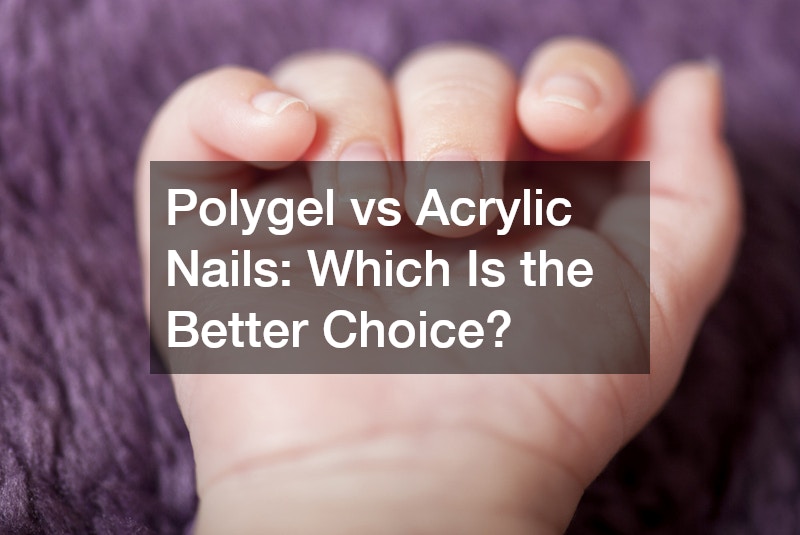When it comes to choosing between polygel and acrylic nails, both options have their distinct benefits and drawbacks. Understanding these can help you make an informed decision based on your preferences and lifestyle. This article explores the differences between polygel and acrylic nails, focusing on their application, feel, durability, safety, cost, and ease of use.
Application Process
The application process for polygel and acrylic nails differs significantly. Polygel is a gel-like substance that requires curing under a UV or LED lamp.
It comes in a pre-made form, which simplifies the application process. You can use it directly from the tube and apply it with plastic or digital forms to achieve the desired shape. One of the advantages of polygel is that it does not harden until it is cured, allowing you to work at your own pace.
In contrast, acrylic nails involve mixing a powder polymer with a liquid monomer to create a workable paste. This mixture must be carefully prepared to achieve the right consistency, making the application process a bit more complex. Acrylic nails harden quickly after application, requiring a more precise and faster application technique.
Feel and Appearance
Polygel nails are known for their light and flexible nature. They tend to feel more natural compared to acrylic nails, which are generally bulkier and heavier. The flexibility of polygel makes it a comfortable option for those who prefer a lighter feel. Additionally, polygel nails often have a natural glossy sheen that enhances their appearance.
Acrylic nails, while durable, can feel heavier and less flexible. However, they can also achieve a glossy finish if a high-quality top coat is applied. The choice between polygel and acrylic can come down to personal preference regarding how natural you want your nails to feel.
Durability
When it comes to durability, acrylic nails have the upper hand. They can last between 6 to 8 weeks with regular fills, making them a long-lasting option for those who want their nails to stay intact for an extended period. Acrylic nails are also more resistant to wear and tear, making them suitable for those with a busy lifestyle.
Polygel nails, on the other hand, typically last around 3 to 4 weeks. While they are less durable than acrylics, they still offer a good amount of longevity. If you prefer to change your nail style more frequently or need something that feels lighter, polygel could be a better choice.
Safety
Safety is a crucial consideration when choosing between polygel and acrylic nails. Both types come with some risks to your natural nails, often related to the application and removal processes. Polygel is generally considered safer for natural nails because it has a more straightforward application and removal process. It also produces less odor compared to acrylic nails, which can be a plus for those sensitive to strong smells.
Acrylic nails can be more damaging due to the use of harsh chemicals during application and removal. The removal process for acrylic nails often involves soaking and filing, which can be rough on the natural nails. It’s essential to choose a reputable beauty salon with experienced technicians to minimize the risk of damage.
One potential drawback of polygel is that it requires UV or LED light for curing. If you are concerned about UV exposure, you might want to consider using sunscreen on your hands or wearing a manicure glove to protect your skin.
Cost
Cost is another factor to consider when deciding between polygel and acrylic nails. Generally, polygel nails are more expensive than acrylic nails. In a beauty salon, polygel manicures can cost between $55 and $120, depending on the design and location. Acrylic nails, on the other hand, typically range from $35 to $95.
If you prefer to do your nails at home, polygel can be more affordable and easier to handle compared to acrylic. DIY polygel kits are often less complicated to use than acrylic, which requires precise mixing and application. This can make polygel a more accessible option for those who want to save money and time.
Ease of Use
In terms of ease of use, polygel has an advantage over acrylic. The pre-made nature of polygel eliminates the need for mixing, making it easier to apply. You can use it directly from the tube and shape it using forms without much difficulty. Polygel also does not harden until cured, giving you more time to perfect your application.
Acrylic nails require a more involved process, including mixing the powder and liquid to achieve the right consistency. The quick hardening of acrylics can also add pressure during application, making it necessary to work swiftly and accurately.
Removal
Removing polygel nails is generally easier than removing acrylic nails. Polygel can be soaked and filed away with less effort, while acrylic nails require extensive filing and soaking to remove. The removal process for acrylics can be more time-consuming and challenging, which might be a consideration if you frequently change your nail style.
Conclusion
Both polygel and acrylic nails offer unique benefits and drawbacks. Polygel provides a lighter, more flexible feel and is easier to apply and remove, but it generally lasts for a shorter period and requires UV light for curing. Acrylic nails are more durable, longer-lasting, and can withstand more wear and tear, but they involve a more complex application process and can be harsher on natural nails.
Ultimately, the choice between polygel and acrylic nails depends on your personal preferences, lifestyle, and budget. If you value a natural feel and ease of use, polygel might be the better option. If durability and longevity are your priorities, acrylic nails could be the way to go. Consider visiting a beauty salon to explore both options and find what works best for you.
.

